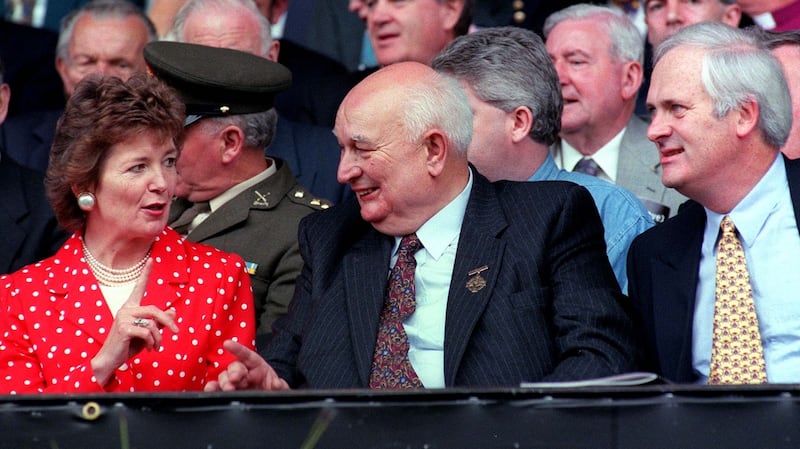The first and unwritten rule of a GAA vigilance committee is that nobody should know who is on a GAA vigilance committee.
The late Jack Boothman didn't quite put it like that, but he might just as well.
Interviewed in 2013 for the GAA oral history project, the colourful former president of the GAA recalled being asked to serve on the Wicklow County Board's vigilance committee, whose job it was to police the enforcement of the association's controversial ban on its members attending or playing so-called foreign games.
Or, indeed, from attending dances run by ‘foreign games’ clubs or hosting ‘foreign dances’ themselves.
Boothman, then new to the ranks of county officialdom, agreed to join the committee on one condition: the names of its members would be publicised and made known to the membership.
The county board said no, so Boothman said the same. “Shag it, I’m not going to be part of any secret society”, he decided.
One of the most remarkable aspects of the GAA’s suite of ban rules, introduced amidst the political and cultural upheavals of the early years of the 20th century, was not just how long they lasted, but how the association went about having them enforced.
From the mid-1920s until the ban’s eventual removal in 1971, the GAA, through its provincial and county boards, operated vigilance committees to ensure the strict implementation of the rules and in doing so they cast a veil of near constant suspicion over its own membership.
Spying
The role of a vigilance committee was, as the writer Breandán Ó hEithir delightfully described it, to spot the “straying sheep among the graceless goats”.
Less delightfully and in reality, this meant spying and reporting on GAA people who’d gone rogue by dipping their toes in sports deemed rival to Gaelic games and alien in origin – English, in other words.
Of course, not all GAA officials viewed the rules with the same reverence and not all vigilance committees applied themselves to their task with the same determined vigour.
In the mid-1920s, the Gaelic Athlete newspaper raged that Vigilance Committees in Dublin and elsewhere were failing to properly implement and enforce the rules, the writer conceding that he’d prefer to see the “GAA smashed in defence of an honest principle than see it existing as a fraud and a farce.”
Yet it was the ban itself that invited no end of farce – and hypocrisy.
A Louth county board delegate in the late 1920s would complain, for instance, that the majority of those "clamouring for the suspension of soccer players were regular attendants at Association Football".
This was not an untypical complaint.

What’s more, so widespread were efforts to get players from opposition teams sanctioned that committee-room wrangling became almost as competitive an endeavour as the games themselves.
This is where the logic of the ban led.
It was perhaps the ultimate gift to chancers and opportunists and, where league points or championship prizes were at stake, the GAA served up no shortage of these. If you couldn’t win a game on the field of play or you wished to secure an advantage in advance, sure why not cast an accusation and try to cleave victory in the committee room instead?
For a spell, Dublin County Board meetings were known to have been dominated by ban-related acrimony and back and forth bickering over players and clubs alleged to have transgressed the foreign games prohibition. Once, in January 1937, a single meeting ended in the suspension of as many as 42 players.
In this case as in others, it is the powerlessness of the suspended players that stands out. As the Evening Herald observed of the Dublin punishments, “the vigilante are unknown and the accused can offer no defence.”
In truth, only a small percentage of those who broke the GAA’s ban rules ever felt a disciplinarian lash.
For all the dismal efforts of vigilance committees and all the administrative energies they thieved from GAA officials at all levels, the ban rules were simply incapable of being policed in a manner that was uniform and consistent.
There was an implicit acknowledgement of this when the Leinster Council issued instructions to its own Vigilance men in 1931. The directive given was that the focus of their efforts should fall on the 'taller poppies'.
The thinking here was simple enough: the better the player, the bigger the name, the greater the ban example that was set.
Profile players also tended to more easily identifiable to the vigilance men. Boothman said that he and players like him flew “under the radar” because they were “no great shakes”.
Professional career
A player like Con Martin, in contrast, was a tall poppy. Midfield on the Dublin team that defeated Carlow in the 1941 Leinster final, Martin missed out on playing on a winning All-Ireland final team after his dual life playing soccer with Drumcondra and GAA with Dublin saw him fall foul of a ban suspension. In Martin's case, the GAA's loss was soccer's gain as he went on to carve out a remarkable professional career in England with Aston Villa and, internationally, with the Republic of Ireland.
In the end, the GAA ban collapsed under the weight of its own contradictions. Even before the arrival of TV rendered it ridiculous - it allowed for living room viewing of soccer from England at the same time as standing on a local sideline was barred - it was increasingly obvious that the GAA rulebook was at odds with the lived reality of the wider GAA membership.
Ridding itself of the ban did not deliver to the GAA all that the leading abolitionists said it would, but it did set the Association on a course where, over time, it would become less and less concerned with prescribing and policing a specific vision of Irishness.
Nowadays, of course, all that – along with scything of “taller poppies” – can be comfortably done online. And with no need for secret societies.












